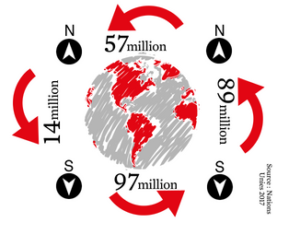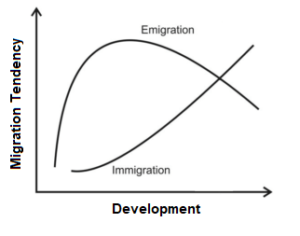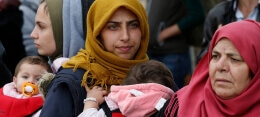Before we start the interview, it should be mentioned that the macroeconomic reasons for migration – income inequality, education level, conflict, demographics – are only part of the story. Other factors such as social and cultural norms, family status or personality traits are equally important factors of migration. All these factors are interlinked.
In 2017, the United Nations counted 258 million migrants (3% of the global population), including 97 million people migrating from South to South, 89 million from South to North, 57 million from North to North and 14 million from North to South.
Migration between countries in the South is thus the most common type of migration (38% of the international migration). It is characterized by interregional movements in Latin America, Africa, and Asia – the latter, particularly to the Gulf States. South-North migration comes second (34.5% of the international migration), including migration from Latin America, Asia, and Africa to Europe, the United States or Australia.
International Migration
Professor Frédéric Docquier brings us his expertise on migration and especially about the macroeconomic factors that explain South-North migration.
WHAT ARE THE MACROECONOMIC EXPLANATIONS FOR MIGRATION?
Frédéric Docquier: Inequalities between countries are an important determinant of South-North migration, but it is not the only one. Other variables (possibly correlated with income level) also have an impact, such as educational level, geography, population structure, networks, etc.
Education is an important determinant of migration, as the educated have a greater tendency to migrate compared to the uneducated, especially when the country is underdeveloped[1].
Educated people come from families that generally have more financial resources and better access to information – two essential prerequisites for sending a family member abroad. Moreover, the migration policies of rich countries often explicitly discriminate against lower educated people.
WHAT IS THE IMPACT OF DEVELOPMENT ON MIGRATION?
Docquier: Some expect that economic development will have a negative impact on migration (that more development would mean less migration).
Actually, the impact varies depending on the level of development of the country: development has a positive impact on migration from low-income countries, an ambiguous impact on middle-income countries and a negative one on the most developed countries.

- Low-income countries: migrating is expensive. Financial constraints are therefore an obstacle to migration in very poor countries. For the latter, more development means more income, and therefore more migration.
- Medium-income countries: these countries are sufficiently developed so that financing migration does not constitute an obstacle. Development here does not affect migration, but rather education. More development means more educated people and therefore a greater tendency to migrate (see above). This by itself would imply more migration, but more education also means a lower birth rate. The net effect of development on the stock of migrants is therefore ambiguous for these countries.
- High-income countries: development has a negative impact on migration, as opportunities abroad become relatively less attractive compared to domestic opportunities.
HAS SOUTH-NORTH MIGRATION CHANGED IN RECENT YEARS?
Docquier: Many people think that everyone wants to leave their country. But leaving your country is a very difficult decision. Only 2-2.5% of the population in developing countries live in rich countries. Since the 1960s, this tendency to migrate from the south has remained fairly stable despite slight upward fluctuations.
This continuity can partly be explained by the fact that international inequalities between rich and poor countries have persisted since the 1960s.[2] The slight upward fluctuations can be explained by the improvement in the level of education (although on average very limited), but also by conflicts. Red.: Conflicts have particularly affected South-South migration since 85% of refugees are being received by developing countries.[3]
However, the number of migrants from the South has increased. In the 1960s, the average number of migrants in the North was 4.5%, of which 1.5% came from the South and 3% from the North. Today, the share of the North has not changed, but that of the South has risen to 8.5%.
WHY HAS THE PROPORTION OF PEOPLE FROM THE SOUTH NOT CHANGED, YET THE QUANTITY HAS
Docquier: This is due to the demographic differences between the North and the South. Proportionally, the population in the South is growing faster than the population in the North. As a result, the number of migrants from the South – and the ratio they represent in the North – has increased. Yet the proportion of people leaving the South has remained virtually the same.
WHAT IMPACT DOES MIGRATION HAVE ON COUNTRIES IN THE SOUTH?
Docquier: On average, migration is positive for all countries of origin at every level of development.[4] Migrants send money to their networks and stimulate trade, the spread of technology and ideas (gender equality, democracy, etc.).
Because of this positive impact, we need to coordinate development and migration policies. A restrictive migration policy and migration barriers influence the impact of our development policy.
FIND OUT MORE
This interview was conducted as part of the #whatishome campaign [5] in which we look for the link between migration and development. What is the link between migration and food security? Migration expert Anna Knoll (European Centre for Development Policy Management) explains. Soon we will also publish an interview with Frédéric Docquier about the impact of migration on the countries of arrival.
Want to know more? Stay informed by subscribing to our Advocacy newsletter, or follow us on Facebook and Twitter.
VIDEO OF THIS INTERVIEW
#whatishome is a three-year social media campaign financed by the European Union in order to raise awareness and to develop education (DEAR) as part of the MIND project. 11 countries and 12 Caritas organizations are participating in this campaign. Click here for more information. The contents of this campaign fall under the responsibility of Caritas International and do not necessarily reflect the official positions of the European Union.

















